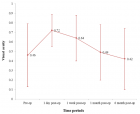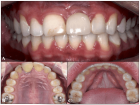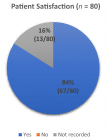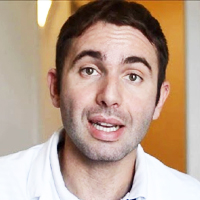Abstract
Opinion
Dalbavancin and moleculight in the COVID-19 pandemic
Wayne J Caputo*, George Fahoury, Donald Beggs and Patricia Monterosa
Published: 11 April, 2023 | Volume 8 - Issue 1 | Pages: 001-003
The COVID-19 Pandemic, which began in March 2020, and its associated surges, had an immense impact on our medical staff and their ability to perform their daily duties.
The COVID-19 Pandemic necessitated hospital modifications, including the expansion of the Emergency Department, ICU, and Isolation units. The overwhelmed staff and overburdened ER and ICU required adjustments to deal with the Inpatient impasse. For example, temporary patient care rooms needed to be set up for the overflow of patients. The tsunami of the Pandemic almost overwhelmed our hospital.
With the challenges presented to our hospital during the Pandemic, we needed a fresh perspective to our multi-disciplinary approach. Thus, we fathomed that the use and cost-effectiveness of both Dalbavancin, a long-acting lipoglycopeptide antibiotic combined with the diagnostic Moleculight Imaging Device would be a sound decision.
We hypothesized that with the use of this cost-effective antibiotic in conjunction with the use of the Moleculight Imaging Device, with its fluorescent imaging, we could detect the presence of bacteria and assist our wound treatment and decision-making.
A shift in patients from the Emergency Room/Inpatient Department to the Outpatient Department/Wound Care Center was made possible with the use of these two novel products.
Read Full Article HTML DOI: 10.29328/journal.jcicm.1001042 Cite this Article Read Full Article PDF
References
- Bolton L. Improving venous ulcer outcomes. Wounds. 2022 Apr;34(4):116-118. doi: 10.25270/wnds/2022.116118. PMID: 35452410.
- Ramsey SD, Newton K, Blough D, McCulloch DK, Sandhu N, Reiber GE, Wagner EH. Incidence, outcomes, and cost of foot ulcers in patients with diabetes. Diabetes Care. 1999 Mar;22(3):382-7. doi: 10.2337/diacare.22.3.382. PMID: 10097914.
- Tennvall GR, Apelqvist J, Eneroth M. Costs of deep foot infections in patients with diabetes mellitus. Pharmacoeconomics. 2000 Sep;18(3):225-38. doi: 10.2165/00019053-200018030-00003. PMID: 11147390.
- Reiber GE. Epidemiology of foot ulcers and amputations in the diabetic In: Bowker JH, Pfeifer MA, Eds. The Diabetic Foot. St. Louis MO: Mosby; 2001. 13-32.
- Fleisher LA, Schreiber M, Cardo D, Srinivasan A. Health Care Safety during the Pandemic and Beyond - Building a System That Ensures Resilience. N Engl J Med. 2022 Feb 17;386(7):609-611. doi: 10.1056/NEJMp2118285. Epub 2022 Feb 12. PMID: 35148040.
- Learish J. The most expensive states for ER visits, ranked. CBS 2020; Dec. 4. https://www.cbsnews.com/pictures/emergency- room-visit-cost-most-expensive-states/
- Dalvance (Dalbavancin) prescribing information. Duralta https://www.rxabbvie.com/pdf/dalvance_pi.pdf
- Serena TE, Gould L, Ousey K, Kirsner RS. Reliance on Clinical Signs and Symptoms Assessment Leads to Misuse of Antimicrobials: Post hocAnalysis of 350 Chronic Wounds. Adv Wound Care (New Rochelle). 2022 Dec;11(12):639-649. doi: 10.1089/wound.2021.0146. Epub 2021 Dec 3. PMID: 34714159; PMCID: PMC9527054.
- The Joint Commission R3 Report Issue 8: New Antibiotic Stewardship Standards. https;//jointcommission.org/standard.
- Gardner SE, Frantz RA, Doebbeling BN. The validity of the clinical signs and symptoms used to identify localized chronic wound infection. Wound Repair Regen. 2001 May-Jun;9(3):178-86. doi: 10.1046/j.1524-475x.2001.00178.x. PMID: 11472613.
- Singh N, Armstrong DG, Lipsky BA. Preventing foot ulcers in patients with diabetes. JAMA. 2005 Jan 12;293(2):217-28. doi: 10.1001/jama.293.2.217. PMID: 15644549.
- Heath,S. Patient Satisfaction and HCAHPS: What It Means for Insights Xtelligent Healthcare Media, May 24, 2016. https:// ptientengagementhit.com/features/patient-satisfaction-and-hcahps-what- it-means-for-providers.
Figures:
Similar Articles
-
Phenibut Overdose in Combination with Fasoracetam: Emerging Drugs of AbuseCristian Merchan*,Ryan Morgan,John Papadopoulos,David Fridman. Phenibut Overdose in Combination with Fasoracetam: Emerging Drugs of Abuse. . 2016 doi: 10.29328/journal.jcicm.1001001; 1: 001-004
-
Nursing Care of ICU Patients Lightly Sedated with DexmedetomidineÅsa Engström*,Maria Johansson,Mia Mattsson,Ulrica Strömbäck. Nursing Care of ICU Patients Lightly Sedated with Dexmedetomidine. . 2016 doi: 10.29328/journal.jcicm.1001002; 1: 005-013
-
Complicated Hepatitis A Virus Infection: A Report of Three Cases from Single Tertiary Referral CenterOmkolsoum M Alhaddad,Maha M Elsabaawy*,Khalid A Gameel,Marwa Elfauomy,Olfat Hendy,Eman A Rewisha. Complicated Hepatitis A Virus Infection: A Report of Three Cases from Single Tertiary Referral Center. . 2016 doi: 10.29328/journal.jcicm.1001003; 1: 014-020
-
Critical Management of Status EpilepticusFarahnaz Fallahian*,Seyed MohammadReza Hashemian*. Critical Management of Status Epilepticus. . 2017 doi: 10.29328/journal.jcicm.1001004; 2: 001-015
-
Comparative Hemodynamic Evaluation of the LUCAS® Device and Manual Chest Compression in Patients with Out-of-Hospital Cardiac ArrestMirek S,Opprecht N*,Daisey A,Milojevitch E,Soudry- Faure A,Freysz M. Comparative Hemodynamic Evaluation of the LUCAS® Device and Manual Chest Compression in Patients with Out-of-Hospital Cardiac Arrest. . 2017 doi: 10.29328/journal.jcicm.1001005; 2: 016-024
-
Chemotherapy Exposure and outcomes of Chronic Lymphoid Leukemia PatientsJosephina G Kuiper*,Patience Musingarimi,Christoph Tapprich,Fernie JA Penning-van Beest,Maren Gaudig. Chemotherapy Exposure and outcomes of Chronic Lymphoid Leukemia Patients. . 2017 doi: 10.29328/journal.jcicm.1001006; 2: 025-033
-
Knowledge, attitude and practices associated with diagnosis and management of Skin and Soft Tissue Infections (SSTIs) among Pediatric Residents and Physicians in a Tertiary Hospital in United Arab Emirates (UAE)Eiman Al Blooshi,Farah Othman,Abeer Al Naqbi,Majid Al Rumaithi,Khawla Fikry,Mariam Al Jneibi,Hossam Al Tatari*. Knowledge, attitude and practices associated with diagnosis and management of Skin and Soft Tissue Infections (SSTIs) among Pediatric Residents and Physicians in a Tertiary Hospital in United Arab Emirates (UAE) . . 2017 doi: 10.29328/journal.jcicm.1001007; 2: 034-039
-
Unusual presentation of a bilateral basilar stroke: BradycardiaZidouh S*,Jidane S,Nabhani T,Chouaib N,Sirbou R,Belkouch,Belyamani L. Unusual presentation of a bilateral basilar stroke: Bradycardia. . 2017 doi: 10.29328/journal.jcicm.1001008; 2: 040-041
-
Sinking Skin Flap SyndromeLiew BS*,Rosman AK,Adnan JS. Sinking Skin Flap Syndrome. . 2017 doi: 10.29328/journal.jcicm.1001009; 2: 042-048
-
Intensive Care Units (ICU): The clinical pharmacist role to improve clinical outcomes and reduce mortality rate- An undeniable functionLuisetto M*,Ghulam Rasool Mashori. Intensive Care Units (ICU): The clinical pharmacist role to improve clinical outcomes and reduce mortality rate- An undeniable function. . 2017 doi: 10.29328/journal.jcicm.1001010; 2: 049-056
Recently Viewed
-
Benzothiazole-derived Compound with Antitumor Activıiy: Molecular Structure Determination Using Density Functional Theory (Dft) MethodHacer Gumus*. Benzothiazole-derived Compound with Antitumor Activıiy: Molecular Structure Determination Using Density Functional Theory (Dft) Method. Ann Proteom Bioinform. 2024: doi: 10.29328/journal.apb.1001023; 8: 001-007
-
Enhancing Physiotherapy Outcomes with Photobiomodulation: A Comprehensive ReviewNivaldo Antonio Parizotto*, Cleber Ferraresi. Enhancing Physiotherapy Outcomes with Photobiomodulation: A Comprehensive Review. J Nov Physiother Rehabil. 2024: doi: 10.29328/journal.jnpr.1001061; 8: 031-038
-
Difference between conventional and modern methods for examination of fingerprintsAmbati Ramesh Babu*. Difference between conventional and modern methods for examination of fingerprints. J Forensic Sci Res. 2021: doi: 10.29328/journal.jfsr.1001025; 5: 037-040
-
Laparoscopic anterior transgastric cystogastrostomy for the treatment of pancreatic pseudocystsFahri Yetisir*,Kerim Güzel. Laparoscopic anterior transgastric cystogastrostomy for the treatment of pancreatic pseudocysts. Ann Clin Gastroenterol Hepatol. 2020: doi: 10.29328/journal.acgh.1001015; 4: 006-010
-
Prognostic implications of vitamin D deficiency in chronic kidney diseaseD Martínez-López,D Jover-Ríos,P Esteve-Atiénzar,J Méndez-Mora,A Méndez-Jover,F Caparrós-Hernández,V Jordá-Climent,C Seguí-Pérez,M Seguí-Pérez,C García-Cervera,JM Núñez-Cruz,J Guzmán-Martínez,I Hernández-Isasi,D Bonet-Tur,S Bañón-Escandell,J Peris-García,P Roig-Rico,A Pérez-Fullana,JM Seguí-Ripoll*. Prognostic implications of vitamin D deficiency in chronic kidney disease. J Clini Nephrol. 2019: doi: 10.29328/journal.jcn.1001040; 3: 148-153
Most Viewed
-
Sinonasal Myxoma Extending into the Orbit in a 4-Year Old: A Case PresentationJulian A Purrinos*, Ramzi Younis. Sinonasal Myxoma Extending into the Orbit in a 4-Year Old: A Case Presentation. Arch Case Rep. 2024 doi: 10.29328/journal.acr.1001099; 8: 075-077
-
Evaluation of Biostimulants Based on Recovered Protein Hydrolysates from Animal By-products as Plant Growth EnhancersH Pérez-Aguilar*, M Lacruz-Asaro, F Arán-Ais. Evaluation of Biostimulants Based on Recovered Protein Hydrolysates from Animal By-products as Plant Growth Enhancers. J Plant Sci Phytopathol. 2023 doi: 10.29328/journal.jpsp.1001104; 7: 042-047
-
Feasibility study of magnetic sensing for detecting single-neuron action potentialsDenis Tonini,Kai Wu,Renata Saha,Jian-Ping Wang*. Feasibility study of magnetic sensing for detecting single-neuron action potentials. Ann Biomed Sci Eng. 2022 doi: 10.29328/journal.abse.1001018; 6: 019-029
-
Physical activity can change the physiological and psychological circumstances during COVID-19 pandemic: A narrative reviewKhashayar Maroufi*. Physical activity can change the physiological and psychological circumstances during COVID-19 pandemic: A narrative review. J Sports Med Ther. 2021 doi: 10.29328/journal.jsmt.1001051; 6: 001-007
-
Pediatric Dysgerminoma: Unveiling a Rare Ovarian TumorFaten Limaiem*, Khalil Saffar, Ahmed Halouani. Pediatric Dysgerminoma: Unveiling a Rare Ovarian Tumor. Arch Case Rep. 2024 doi: 10.29328/journal.acr.1001087; 8: 010-013

HSPI: We're glad you're here. Please click "create a new Query" if you are a new visitor to our website and need further information from us.
If you are already a member of our network and need to keep track of any developments regarding a question you have already submitted, click "take me to my Query."



















































































































































